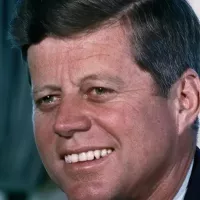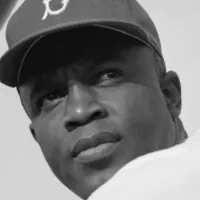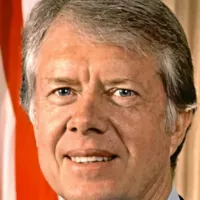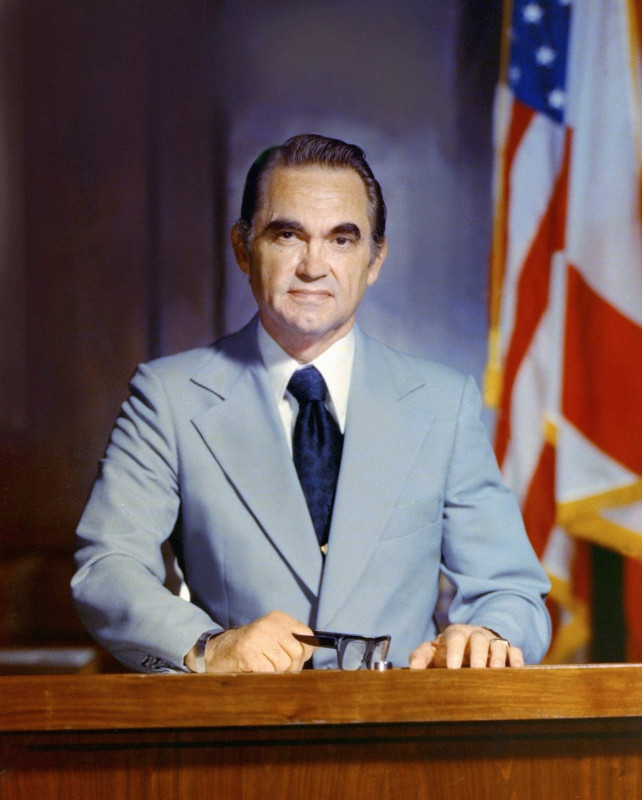George Wallace was a prominent American politician, best known as the four-term governor of Alabama. Initially a staunch segregationist, he gained national notoriety for his defiant stance against the Civil Rights Movement, symbolized by his 1963 inaugural address vowing "segregation forever." He unsuccessfully ran for US President multiple times, including a significant third-party bid in 1968. Later in his career, Wallace publicly renounced his segregationist views. Despite his controversial legacy regarding race, Wallace also focused on economic development initiatives during his time as governor.
August 25, 1919: Birth of George Wallace
On August 25, 1919, George Corley Wallace Jr. was born. He would later become the 45th and longest-serving governor of Alabama and a prominent figure known for his segregationist views.
1935: Page in the Alabama Senate
In 1935, George Wallace won a contest to serve as a page in the Alabama Senate, where he predicted he would one day be governor.
1937: Enrollment in Law School
In 1937, George Wallace enrolled in law school at the University of Alabama School of Law in Tuscaloosa.
1937: Death of Wallace's Father
In 1937, George Wallace's father died, leading his mother to sell their farmland to pay existing mortgages.
1938: Campaign Contribution
In 1938, at age 19, George Wallace contributed to his grandfather's successful campaign for probate judge.
1939: Cornelia Ellis Snively Born
In 1939, Cornelia Ellis Snively was born.
1942: Received Law Degree
In 1942, George Wallace received a Bachelor of Laws degree.
May 22, 1943: Wallace marries Lurleen Brigham Burns
On May 22, 1943, George Wallace married Lurleen Brigham Burns.
1943: Accepted for Pilot Training
Early in 1943, George Wallace was accepted for pilot training by the United States Army Air Forces (USAAF). He then contracted spinal meningitis, causing hearing loss and nerve damage, leading him to train as a flight engineer instead.
1944: Birth of Bobbi Jo Parsons
In 1944, Bobbi Jo Parsons, the daughter of George and Lurleen Wallace, was born.
1945: Served in Air Raids on Japan
During 1945, George Wallace participated in air raids on Japan as a member of a B-29 crew with the 468th Bombardment Group, stationed in the Mariana Islands. He then received an early discharge on medical grounds, due to "severe anxiety".
1945: Appointment as Assistant Attorney General
Late in 1945, George Wallace was appointed as one of the assistant attorneys general of Alabama.
1947: Establishment of the United States Air Force
Curtis LeMay was instrumental in the establishment in 1947 of the United States Air Force and an expert in military affairs.
1948: Delegate to Democratic National Convention
In 1948, George Wallace was a delegate to the Democratic National Convention and did not join the Dixiecrat walkout, despite his opposition to U.S. President Harry S. Truman's proposed civil rights program, considering it an infringement on states' rights.
1948: Avoiding race-related discussions
In 1948, unlike Strom Thurmond, George Wallace generally avoided race-related discussions, focusing instead on criticizing hippies and "pointy-headed intellectuals." He denied being racist.
1950: Birth of Peggy Sue Kennedy
In 1950, Peggy Sue Kennedy, the daughter of George and Lurleen Wallace, was born.
1951: Birth of George Wallace III
In 1951, George Wallace III, the son of George and Lurleen Wallace, was born.
1952: Became Circuit Judge
In 1952, George Wallace became the Circuit Judge of the Third Judicial Circuit in Alabama, where he gained a reputation for fairness regardless of the race of the plaintiff. He was also known as "the fighting little judge", a nod to his past boxing association.
1958: First Gubernatorial Nomination Attempt
In 1958, George Wallace first sought the Democratic nomination in the Alabama gubernatorial election. Initially a moderate on racial issues, he lost the nomination. This loss led him to adopt a hard-line segregationist stance.
1958: Granted Probation to Black People
In 1958, as judge, George Wallace granted probation to some Black people, which may have negatively impacted his chances in the 1958 gubernatorial election. This highlights a complex aspect of his early career.
1959: Cited for Contempt of Court
In 1959, during efforts to expand voter registration of Black people, George Wallace blocked federal efforts to review Barbour County voting lists and was cited for criminal contempt of court.
1961: Birth of Janie Lee Wallace
In 1961, Janie Lee Wallace, the daughter of George and Lurleen Wallace, was born.
1961: Lurleen Wallace Cancer Diagnosis
In 1961, Lurleen Wallace was diagnosed with cancer, but George Wallace did not inform her of the diagnosis.
1962: Won Democratic Nomination for Governor
In 1962, George Wallace finished first in the Democratic primary and then won the runoff, securing the nomination for governor. As no Republican filed to run, this virtually assured his victory.
1962: Staff knew about Lurleen's cancer since 1962
Staff members knew about Lurleen Wallace's cancer since George Wallace's 1962 campaign three years earlier.
January 14, 1963: Inauguration as Governor
On January 14, 1963, George Wallace took the oath of office as governor of Alabama. This occurred on the gold star marking the spot where Jefferson Davis was sworn in as provisional president of the Confederate States of America.
June 11, 1963: "Stand in the Schoolhouse Door"
On June 11, 1963, Governor George Wallace stood in front of Foster Auditorium at the University of Alabama in a vain attempt to halt the enrollment of Black students Vivian Malone and James Hood. This event is known as the "Stand in the Schoolhouse Door."
September 1963: Attempt to Stop School Integration in Huntsville
In September 1963, George Wallace attempted to stop four Black students from enrolling in four separate elementary schools in Huntsville. A federal court intervened, and the children were allowed to enter on September 9, becoming the first to integrate a primary or secondary school in Alabama.
1963: Profession of Segregationist Beliefs
A source on Wallace's career as a judge reports that, after 1963, he professed to be a segregationist, not a racist, despite being considered fair by Black attorneys in his courtroom. This highlights the complexities and contradictions in his public and private stances on race.
1963: Wallace's views on race
In 1963 Wallace wrote a letter to a teacher stating that Black Americans were inclined to criminality because of a high incidence of venereal disease, and desegregation would lead to "intermarriage ... and eventually our race will be deteriated [sic] to that of the mongrel complexity."
1963: Wallace becomes Governor of Alabama
In 1963, George Wallace began his first term as the governor of Alabama, during which he famously declared "segregation now, segregation tomorrow, and segregation forever." This marked the beginning of his staunch opposition to desegregation during the Civil Rights Movement. The period was between 1963 and 1967.
1963: University of South Alabama Chartered
In 1963, during George Wallace's first year as governor, the University of South Alabama was chartered in Mobile.
1963: Announcement of Presidential Candidacy
In November 1963, George Wallace announced his intention to oppose John F. Kennedy for the 1964 Democratic presidential nomination in Dallas.
1963: Inaugural Speech as Governor
In his 1963 inaugural speech as governor, Wallace excused his failure to walk out of the 1948 Democratic Convention on political grounds.
1964: Federal Civil Rights Legislation Passed
Federal civil rights legislation was passed in 1964.
1964: Kennedy Assassination and Johnson Succession
Following Wallace's announcement, in 1964, John F. Kennedy was assassinated in Dallas, and Lyndon B. Johnson became president.
1964: Presidential Primary Challenge
In 1964, George Wallace challenged sitting president Lyndon B. Johnson in the Democratic presidential primaries, but Johnson prevailed in the race.
1964: Fiery Speech in Cincinnati
In 1964, George Wallace delivered a particularly fiery speech in Cincinnati, Ohio, where he angrily denounced protesters as "little Pinkos," inciting the audience.
1964: Wallace's Presidential Aspirations
In 1964, George Wallace sacrificed his own presidential aspirations to allow a direct Republican challenge to President Johnson.
1964: Republican Victory in Alabama
In 1964, Republican electors prevailed in Alabama for the first time since Reconstruction, with the Goldwater-Miller slate receiving 69.5 percent of the vote.
1964: Dissatisfaction with the Civil Rights Act
In 1964, Wallace mostly attracted the Southern Democrats who were dissatisfied with the 1964 Civil Rights Act signed by President Lyndon B. Johnson.
1964: Entry into Democratic Primaries
In 1964, leveraging the controversy from the University of Alabama incident, Wallace entered the Democratic primaries, campaigning against integration and advocating a strict approach to crime.
1964: Honorary Doctorate from Bob Jones University
In the spring of 1964, George Wallace received an honorary doctorate from Bob Jones University in Greenville, South Carolina.
1965: Federal Civil Rights Legislation Passed
Federal civil rights legislation was passed in 1965.
1965: Lurleen Wallace diagnosed with uterine cancer
In 1965, Lurleen Wallace was diagnosed with uterine cancer after experiencing abnormal bleeding.
1965: Dissatisfaction with the Voting Rights Act
In 1965, Wallace mostly attracted the Southern Democrats who were dissatisfied with the 1965 Voting Rights Act signed by President Lyndon B. Johnson.
November 8, 1966: Lurleen Wallace Defeats Martin
On November 8, 1966, Lurleen Wallace defeated Martin in the general election, becoming governor of Alabama.
1966: Legislation to Nullify Desegregation Guidelines
During the 1966 campaign, George Wallace signed state legislation to nullify desegregation guidelines, claiming it would prevent federal intervention in schools.
1966: Defending Proxy Candidacy
In 1966, George Wallace defended his wife's proxy candidacy, noting her ability to "charm crowds."
1966: Lurleen Wallace's Candidacy
In 1966, due to term limits, Wallace's wife, Lurleen Wallace, ran as a surrogate candidate for governor and won in the Democratic primary.
January 1967: Lurleen Wallace Inaugurated
In January 1967, Lurleen Wallace was inaugurated as governor of Alabama.
March 1967: Strategy Session for 1968 Presidential Campaign
On the evening of Lurleen Wallace's March 1967 inauguration, a strategy session was held for George Wallace's 1968 presidential campaign with prominent white supremacists and anti-Semites.
1967: End of First Term as Governor
In 1967, George Wallace left office when his first term as governor of Alabama expired due to term limits. His wife, Lurleen, succeeded him in the next election. This was effectively circumventing the rule as he was de facto governor during her time in office.
April 1968: Wallace lies about Lurleen's cancer condition
In April 1968, George Wallace claimed that his wife Lurleen had "won the fight" against cancer, despite her deteriorating condition.
May 7, 1968: Death of Lurleen Wallace
On May 7, 1968, Lurleen Wallace died in office of cancer at the age of 41, during her husband's second presidential campaign.
May 1968: Death of Lurleen Wallace
In May 1968, Lurleen Wallace, George Wallace's wife who had succeeded him as governor, died of cancer. Her doctor had informed George Wallace of the cancer's diagnosis in 1961, but he had not told her. Her death marked the end of Wallace's period of influence as de facto governor.
1968: Curtis LeMay as Running Mate
Curtis LeMay, the commander of the Twentieth Air Force during Wallace's service in 1945, was his running mate in the 1968 presidential race.
1968: Third-Party Presidential Campaign
In 1968, George Wallace ran a third-party campaign in an attempt to force a contingent election in the United States House of Representatives, thereby enhancing the political clout of segregationist Southern leaders. Wallace won five Southern states but failed to force a contingent election.
1968: Wallace campaign permeated by extremist groups
In 1968, George Wallace's campaign was significantly influenced by extremist groups such as White Citizens' Councils. Although Wallace never openly sought their support, he also never refused it. The Liberty Lobby, a pro-Nazi and white supremacist organization, even distributed a pro-Wallace pamphlet called "Stand up for America".
1968: Included Senator George McGovern
In 1968, Senator George McGovern and former U.S. vice president Hubert Humphrey ran as Democratic opponents.
1968: Wallace's Rhetoric
In 1968, Wallace made controversial statements, including a pledge about anarchists and an assertion about hippies.
1968: Presidential Campaign as American Independent Party Candidate
In 1968, Wallace ran for president as the American Independent Party candidate, aiming to influence the House of Representatives and end federal desegregation efforts. His platform included Social Security and Medicare increases.
1968: Presidential Run with the American Independent Party
In 1968, Wallace ran for the United States presidency with the American Independent Party, carrying five states. This third-party bid highlighted his segregationist views on a national level. He had previously unsuccessfully sought the United States presidency as a Democrat three times.
1968: Curtis LeMay as Vice President
In 1968, after retracting the invitation to Happy Chandler, Wallace chose Curtis LeMay, a former Air Force General, as his running mate.
1968: Impact from the 1968 Campaign
In Wallace's 1998 obituary, The Huntsville Times summarized the impact from the 1968 campaign
1968: Consideration of Happy Chandler as Running Mate
In his 1968 campaign, Wallace considered Happy Chandler, a former baseball commissioner and governor/senator of Kentucky, as his running mate to bring in "decent people" but faced objections due to Chandler's support for Jackie Robinson.
1969: Nixon institutes affirmative action program
In 1969, Nixon instituted the first affirmative action program, the Philadelphia Plan. Wallace also expressed continued opposition to desegregation busing.
1970: George Wallace's Next Bid for Election
Following his wife Lurleen's death, George Wallace's influence in state government subsided until his next bid for election in his own right in 1970.
1970: Wallace seeks Democratic nomination against Albert Brewer
In 1970, George Wallace ran for the Democratic nomination against incumbent governor Albert Brewer. Brewer sought African American voter support and unveiled a progressive platform. Brewer criticized Wallace's out-of-state trips.
1970: Re-election as Governor
In 1970, George Wallace won election to the governorship again.
January 4, 1971: Wallace marries Cornelia Ellis Snively
On January 4, 1971, George Wallace married Cornelia Ellis Snively, a niece of former Alabama governor Jim Folsom.
1971: Attacking Concentrated Wealth
In 1971, Jack Newfield observed that George Wallace's speeches echoed William Jennings Bryan as he attacked concentrated wealth.
January 13, 1972: Wallace declares candidacy
On January 13, 1972, George Wallace declared himself a Democratic candidate for president, joining a field that included George McGovern, Hubert Humphrey, and nine other opponents.
May 15, 1972: Wallace shot at Laurel Shopping Center
On May 15, 1972, George Wallace was shot four times by Arthur Bremer at the Laurel Shopping Center in Laurel, Maryland. The shooting left Wallace paralyzed from the waist down, effectively ending his presidential bid. Three others were also wounded.
August 4, 1972: Bremer sentenced to prison
On August 4, 1972, Arthur Bremer was sentenced to 63 years in prison for shooting George Wallace. The sentence was later reduced to 53 years.
1972: Wallace campaigns for president
In 1972, George Wallace campaigned for the United States presidential election after promising not to run a third time. He ran "one of the nastiest campaigns in state history", using racist rhetoric.
1972: Presidential Primary Campaign Ended by Shooting
In 1972, George Wallace ran in the Democratic presidential primaries, his campaign effectively ended when he was shot in Maryland by Arthur Bremer, which left Wallace paralyzed below the waist for the remainder of his life.
1973: George Wallace Tunnel Constructed
In 1973, the George Wallace Tunnel on Interstate 10 was constructed and named for him.
1974: Wallace wins primary and general election
In 1974, George Wallace easily won the primary and general election, defeating Republican State Senator Elvin McCary.
November 1975: Wallace announces fourth bid for presidency
In November 1975, George Wallace announced his fourth bid for the presidency, participating in the Democratic presidential primaries. His campaign was affected by voter concerns about his health and media portrayal.
1975: George C. Wallace Speech and Hearing Center
In 1975, the George C. Wallace Speech and Hearing Center was named via Act 110 by the Alabama Legislature.
June 1976: Wallace leaves presidential race
In June 1976, after losing several Southern primaries to Jimmy Carter, George Wallace left the presidential race and endorsed Carter.
1976: Unsuccessful Presidential Nomination Attempt
In 1976, George Wallace unsuccessfully sought the Democratic presidential nomination.
1978: Wallace and Snively divorce
In 1978, George Wallace and Cornelia Ellis Snively had a bitter divorce.
1979: Wallace Leaves Office
In 1979, George Wallace left office after serving as governor.
1979: Wallace apologizes for segregationist past
In 1979, George Wallace said of his stand in the schoolhouse door: "I was wrong. Those days are over, and they ought to be over." He publicly asked for forgiveness from Black Americans.
September 9, 1981: Wallace marries Lisa Taylor
On September 9, 1981, George Wallace married Lisa Taylor, a country music singer.
1982: Wallace presents himself as politically progressive
During the 1982 election, George Wallace presented himself as politically progressive.
1982: Re-election to Fourth Term as Governor
In 1982, George Wallace re-entered politics and won election to a fourth, and final, term as governor of Alabama.
1982: Wallace wins Democratic nomination
In 1982, George Wallace won the Democratic nomination for governor by a margin of 51 to 49 percent. In the general election, his opponent was Montgomery Republican Mayor Emory Folmar.
1983: Wallace appoints Black Americans to state positions
During George Wallace's final term as governor, starting in 1983, he appointed a record number of Black Americans to state positions.
April 2, 1986: Wallace announces retirement
On April 2, 1986, George Wallace announced that he would not run for a fifth term as Governor of Alabama and would retire from public life.
January 1987: Wallace leaves governor's mansion
In January 1987, George Wallace left the governor's mansion, marking his retirement from public life.
February 2, 1987: Wallace and Taylor divorce
On February 2, 1987, George Wallace and Lisa Taylor divorced, weeks after Wallace left office for the fourth and final time.
1987: End of Wallace's final term as governor
George Wallace's final term as governor ended in 1987.
1992: Wallace votes for George H. W. Bush
In 1992, George Wallace revealed that he had voted for George H. W. Bush, another Republican.
1992: Wallace comments on assassination attempt
In 1992, when asked to comment on the 20th anniversary of his attempted assassination, George Wallace replied, "I've had 20 years of pain."
1993: William Louis Dickinson Holds Seat Until 1993
In 1964, Republican tide also brought to victory five Republican members of the United States House of Representatives, including William Louis Dickinson, who held the Montgomery-based district seat until 1993.
1995: Wallace plans to vote for Bob Dole
In a 1995 interview, George Wallace said that he planned to vote for Republican Bob Dole in the 1996 presidential election.
October 1996: Wallace presents award to Vivian Malone Jones
In October 1996, George Wallace presented the first Lurleen B. Wallace Award of Courage to Vivian Malone Jones and apologized for his past conduct.
1996: Planned vote for Republican Bob Dole
In 1996, George Wallace announced his plan to vote for Republican Bob Dole in the presidential election.
1996: Hood starts book on Wallace
In 1996, James Hood started a book on George Wallace and interviewed him extensively.
1997: Hood graduates, Wallace unable to present degree
In 1997, James Hood graduated and requested that George Wallace present his degree, but Wallace was unable to due to poor health.
1997: George Wallace Movie
In 1997, the TNT cable network produced a movie titled "George Wallace", directed by John Frankenheimer and starring Gary Sinise.
September 13, 1998: Death of George Wallace
On September 13, 1998, George Corley Wallace Jr. died, marking the end of the life of the former Alabama governor known for his controversial stance on segregation which he later renounced.
1998: Hood attends Wallace's funeral
In 1998, James Hood attended George Wallace's funeral.
1998: Wallace's Obituary and Legacy
In Wallace's 1998 obituary, The Huntsville Times political editor John Anderson summarized the impact from the 1968 campaign.
2000: George Wallace: Settin' the Woods on Fire Documentary
In 2000, a documentary about George Wallace, titled "George Wallace: Settin' the Woods on Fire", was shown by PBS on The American Experience.
2002: Path to War Film
In 2002, Gary Sinise reprised his role as George Wallace in the film "Path to War".
2006: Wallace Jr. loses race for lieutenant governor
In 2006, George Wallace Jr. lost a race for the Republican nomination for lieutenant governor.
November 9, 2007: Bremer released on parole
On November 9, 2007, Arthur Bremer was released on parole after serving 35 years in prison for shooting George Wallace.
January 8, 2009: Cornelia Snively dies
On January 8, 2009, Cornelia Snively, George Wallace's former wife, died at the age of 69.
2010: Wallace Jr. fails to regain state treasurer position
In 2010, George Wallace Jr. failed to win the Republican nomination to regain his former position as state treasurer.
2014: Selma Film
In the 2014 film "Selma", set during the Civil Rights Movement, George Wallace was portrayed by actor Tim Roth.
2020: Calls to Rename Buildings Named After Wallace
In 2020, amidst a change in public opinion, many Alabama universities were pushed to rename campus buildings that were originally named after Wallace, including the University of Montevallo and Auburn University.
2024: Wallace Remains Most Recent Third-Party Candidate
As of the 2024 election, Wallace remains the most recent third-party candidate to receive pledged electoral college votes from any state.
Mentioned in this timeline

John F Kennedy JFK was the th U S President...
The United States of America is a federal republic located...

Interstate I- is the southernmost transcontinental highway in the United...

Jackie Robinson was an American professional baseball player who broke...
Japan is an East Asian island country situated in the...

Jimmy Carter the th U S President - was a...
Trending

24 minutes ago De'Aaron Fox NBA fantasy picks, DFS, betting tips and player props.

25 minutes ago Spurs Defeat Nuggets in Thrilling Game, Mavericks Face Nuggets

25 minutes ago Anthony Edwards Leads Timberwolves to Victory, Sets Franchise Record Against Spurs.

1 hour ago Karl-Anthony Towns Expresses Desire to Extend Stay with Knicks Amid Contract Stalls
1 hour ago Early smartphone use linked to increased health risks in young children: New study.

1 hour ago Trump's performance at December 2025 Cabinet meeting raises concerns about his health and focus.
Popular
Aftyn Alyssa Behn is an American politician currently serving as...
Matt and Ross Duffer known as the Duffer Brothers are...

XXXTentacion born Jahseh Dwayne Ricardo Onfroy was a controversial yet...

Stranger Things created by the Duffer Brothers is a popular...

Lane Kiffin is an American football coach currently serving as...

William Franklin Graham III commonly known as Franklin Graham is...
